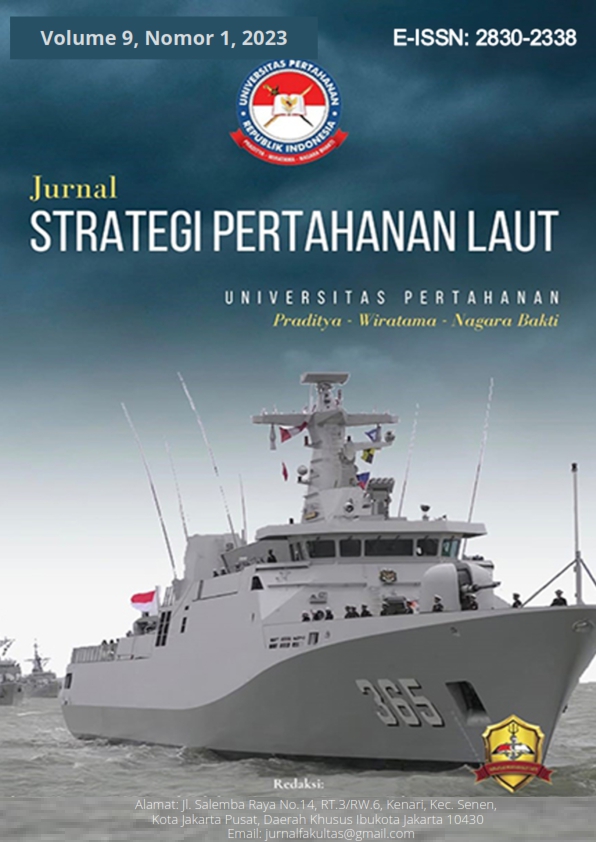PENERAPAN KONSEP SINGLE WINDOW SEBAGAI STRATEGI MARITIM DALAM MENJAGA KEAMANAN MARITIM INDONESIA
DOI:
https://doi.org/10.33172/spl.v9i1.11549Abstract
Keamanan maritim atau maritime security merupakan perluasan dari konsep keamanan setelah terjadinya perang dingin. Keamanan maritim juga merujuk kepada suatu strategi yang digunakan oleh angkatan laut dalam melakukan penjagaan dan juga pengamanan terhadap batas-batas nasional wilayah maritim serta area rawan di laut yang digunakan sebagai jalur perdagangan internasional. Indonesia merupakan negara yang memiliki lima choke points dan juga tiga Alur Laut Kepulauan Indonesia (ALKI) yang sangat aktif dan padat, serta bersifat ‘terbuka’ atau dapat diakses oleh negara-negara lain. Dengan sifat seperti itu tidak menutup kemungkinan akan adanya potensi ancaman yang terjadi di wilayah maritim Indonesia. Maka diperlukan suatu strategi yang dapat digunakan sebagai strategi maritim yang dapat mempertahankan keamanan maritim Indonesia, yakni dengan menerapkan konsep single window dengan tujuan untuk mengintegrasi tugas dan juga wewenang dari berbagai instansi yang berkaitan dengan national maritime securityReferences
Andriyany, Dwi P. (2021). “Analisis Konsep Produktivitas dan Faktor-Faktor yang Mempengaruhi Produktivitas Kerja Karyawan (Studi Literatur)”. Skripsi. STIE PGRI Dewantara Jombang.
Ardianto, Yoni. (2019). “Memahami Metode Penelitian Kualitatif”. Retrieved from https://www.djkn.kemenkeu.go.id/artikel/baca/12773/Memahami-Metode-Penelitian-Kualitatif.html
Bueger, C. (2015). What is Maritime Security?, Marine Policy
Gischa, Serafica. (2022). 3 Pembagian Wilayah Laut Indonesia retrieved from https://www.kompas.com/skola/read/2019/12/17/180000069/3-pembagian-wilayah-laut-indonesia?page=all diakses pada 3 Juli 2022
Kemenko Kemaritiman. (2017). Wilayah Perairan, hak Berdaulat, Kawasan Yurisdiksi, serta Laut Lepas dan Kawasan Dasar Laut Internasional dalam Buku Pedoman Kemenko Kemaritiman RI Kebijakan Kelautan Indonesia
Klein, N. (2010). Maritime Security: International Law and Perspective Policy Perspective from Australia and New Zealand, Routledge, London
Martohandoyo, Harun A.R., et al. (2008). Strategi Penerapan National Single Window di Pelabuhan Tanjung Emas Semarang (Suatu Konsep dari Studi Kasus di Pelabuhan Tanjung Emas Semarang)
Masdiana, A. (2017). Penguatan Keamanan Maritim Indonesia: Memahami Ancaman Keamanan Maritim dan Rekonstruksi Kemaritiman Indonesia menuju Poros Maritim Dunia
Miles, Matthew. B., A. Michael Huberman, & Johnny Saldana. (2014). Qualitative Data Analysis: A Methods Sourcebook, 3rd Edition. USA: Sage Publications
Pramandita, Wisnu. (2022). BAKAMLA RI dan Tantangan Tata Kelola Kamla (Power Point Slides)
PP Nomor 32 Tahun 2022 tentang Neraca Komoditas
Rahman, C. (2009). Concept of Maritime Security. New Zealand: Centre for Strategic Studies
Saraswati, Ayu L., et al. (2020). Strategi Keamanan Maritim Indonesia terhadap Maritime Piracy di Laut Sulu Tahun 2016 dalam Jurnal Transformasi Global Universitas Brawijaya
Shaid, Nur J. (2022). Negara Maritim: Pengertian, Ciri-ciri dan Pilar Penyangganya retrieved from https://money.kompas.com/read/2022/01/19/080215326/negara-maritim-pengertian-ciri-ciri-dan-pilar-penyangganya?page=all diakses pada 3 Juli 2022
Published
How to Cite
Issue
Section
License
Proposed Policy for Journals That Offer Open Access. Authors who publish with this journal agree to the following terms:
- Authors retain copyright and grant the journal right of first publication with the work simultaneously licensed under a Creative Commons Attribution License that allows others to share the work with an acknowledgment of the work's authorship and initial publication in this journal.
- Authors are able to enter into separate, additional contractual arrangements for the non-exclusive distribution of the journal's published version of the work (e.g., post it to an institutional repository or publish it in a book), with an acknowledgment of its initial publication in this journal.
- Authors are permitted and encouraged to post their work online (e.g., in institutional repositories or on their website) prior to and during the submission process, as it can lead to productive exchanges, as well as earlier and greater citation of published work (See The Effect of Open Access).
Proposed Policy for Journals That Offer Delayed Open Access. Authors who publish with this journal agree to the following terms:
- Authors retain copyright and grant the journal right of first publication, with the work [SPECIFY PERIOD OF TIME] after publication simultaneously licensed under a Creative Commons Attribution License that allows others to share the work with an acknowledgment of the work's authorship and initial publication in this journal.
- Authors are able to enter into separate, additional contractual arrangements for the non-exclusive distribution of the journal's published version of the work (e.g., post it to an institutional repository or publish it in a book), with an acknowledgment of its initial publication in this journal.
Authors are permitted and encouraged to post their work online (e.g., in institutional repositories or on their website) prior to and during the submission process, as it can lead to productive exchanges, as well as earlier and greater citation of published work (See The Effect of Open Access)

